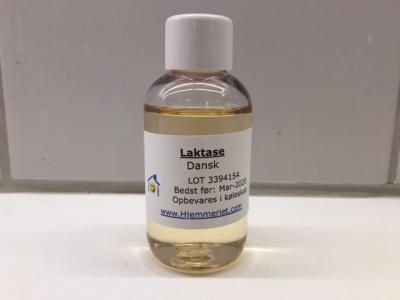Webshop
My page
 See Product Group See Product Group
|
Read more about Cheese |
Add to cart
|
|
|

|
Enzym til fødevarer. Må kun anvendes til fremstilling af laktosefri mælk. |
Lactase is the enzyme that naturally breaks down Lactose (milk sugar) into glucose and galactose.
Lactase can be useful for people with an intolerance to lactose that do therefore not tolerate dairy products such as yoghurt, butter or cheese very well.
Lactase can be taken with a glass of water before or during a lactose-containing meal to promote the breakdown of latose.
Lactase enzyme can also be applyed to milk and cream for a partial or complete breakdown of lactose which will sometimes allow people with low grade lactose intolerance to tolerate milk. This lactase enzyme treated milk can also be used to make soured milk, yogurt, sour cream, butter and cheese from. Just note: The milk must be treated with lactase enzyme before you ferment as Lactase does not work below pH 5.5. Always add this enzyme and give it time to work on the lactose in the milk before you use it to make yogurts, butter or cheese etc.
Note: Lactose intolerance is not to be confused with an allergy to dairy which is allergic response to the milk proteins. Adding lactase does not break down these proteins nor reduce any symptoms in response to this type of allergic reaction.
|
Loading...
Content
This product is Lactase in liquid form. DosageThe concentration of lactase is given in units of NLU (Neutral Lactase Units) per ml. The higher concentration of lactase the faster the lactose will be broken down into glucose and galactose. The concentration of our lactase is 5200 NLU per ml. If you have previously used lactase in a different concentration, you will need to adjust the dosage according to the difference. The lactase can be dosed with a glass dropper or with plastic droppers. If you need further reduction of the lactose, use 1 ml more lactase per liter of milk and/or leave the milk for longer time before consuming it. The milk could also be heated to maximum 48°C and left to cool off for about 4 hours. Please note, each person is different and there are degrees of lactose intolerance, and you may have to experiment to find out what is the right dosage for you. Note om dosering af bakteriekulturer og enzymer
Storage and DurabilityKeep refrigerated. Do not freeze as this will destroy the lactase. If stored properly (refrigerator) the lactase stays active for several years. RecipeProduction of lactose-free milk/cream: For low lactose intolerance:
In case of severe lactose intolerance yo may need to use larger doses of lactase and/or leave for longer period of time. Making lactose-free soured milk and yogurt: For low lactose intolerance, mix lactase with milk and produce the soured milk/yogurt in the normal way. For moderate to severe lactose intolerance, follow the procedure as given above to give lactose free milk, then follow the standard procedures for making soured milk and yogurts. Note : Lactase will have reduced effect if added straight to fermented/soured milk products, because lactase is deactivated after 10 minutes at pH below 5.5, hence it is better if the lactase is added to the milk before fermentation is carried out. Production of lactose-free cheese: For low lactose intolerance, mix the lactase with milk the night prior to making the cheese. It is possibly to leave the milk at room temperature over night, this will slowly increase the milk temperaturease, which is advantageous both for cheese production as well as for enhancing lactose break down. For moderate to severe lactose intolerance, follow the procedure as given above to produce lactose free milk, then proceed to make the cheese following the normal standard procedures. Making lactose-free butter: For low lactose intolerance add lactase along with the acidifying culture, then follow the standard procedure for making butter. BackgroundWhat is lactose intolerance? Milk contains lactose, proteins, fats and minerals. Babis and other baby mammals breaks down and convert milk in to nutrients by enzymatic breakdown (lactase, among others) in our intestinal tract. When the intake of milk decreases or completely stop, the production of these enzymes in our intestinal system will naturally decrease, sometimes to none. A large percentage of the population however, have the ability to produce lactase as adults and these people will not experience any discomfort by consuming dairy. Most of the adult population in Northern Europe and North America have the ability to produce lactase, while the majority of the adult population on Earth (and about 5% of the Danish population) do not have this ability. If they consume lactose, and it is not broken down by lactase, other degradation processes will take place and possibly result in constipantion or diarrhea. Milk products treated with lactase also has the following benefits:
How lactase is produced... Lactase is produced by means of the micro-organism, Kluyveromyces lactis. The microorganisms are fed a vegetable substrate and will produce a neutral β-galactosidase (lactase). The lactase is separated from the micro-organisms and they are therefore not present in the end product. For further information, please read the product leaflet - you will find it below the product image. MiscellaneousThe break down time of lactose depends on how long it acts on the milk, at what temperature and the amount of lactase you use – see the illustrations below.
Figure 1 shows the activity of lactase relative to the temperature. The temperature must be between 0°C and 48°C. Although lactose breakdown increases almost 10 times the speed at higher temperature, we recommend a lower temperature in order to reduce the risk of bacterial growth. The easiest way, is to let lactase work on the milk while the milk is refrigerated, at approximately 5°C. DocumentsFood stuff documents: Facts
|
|||||||||||||||||||||||||||||||||||||
|
|





























































































































































































 In stock
In stock 

 7/0
- Visitors: 1440989 - 1
7/0
- Visitors: 1440989 - 1